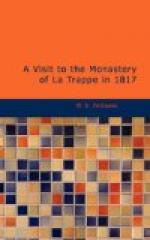Le Marais, which is also comprehended within the limits of Le Bocage, is that part of Lower Poitou, adjacent to the sea. There the country is open and flat, and the passes are impracticable during the winter, and very difficult at other seasons of the year. The inhabitants of Le Marais formed a division of the army of the celebrated chief Charette. La Vendee was divided into two circuits; each army had its own, until the junction of the whole under La Roche-Jaquelin, &c; that of Charette occupied the district of Chalans, Machecoul, la Roche Sur Yon, les Sables, a part of the districts of St. Florent, Vehiers, Chollet, Chatillon, la Chataigneraie, a great part of the districts of Clisson, Montaigne, Thouars, Parthenay, and Fontenay-le-peuple. Although the locality of Le Bocage is a perfect contrast to that of le Marais, nature seems to have exerted all her power in forming these two districts into one extensive fortress, capable of opposing every thing to an attack, and presenting so many means of defence, that it was rarely possible for the enemy to lead a column, or to regulate its movements so as to preserve union in its marches or manoeuvres, dispositions for an attack, or retreat. The positions of the Vendeans could never be understood, or their projects foreseen, in a country where the frequent undulations of land, hedges, trees, and bushes, obstructing the surface, would not admit of seeing fifty paces round; and one of the republican generals, writing to the Convention, thus speaks of Charette’s movements. “It is no easy matter to find Charette, particularly to bring him to action. To-day at the head of ten thousand men, the next day wandering with a score of horsemen, it is very rare that one can come up with him. When we believed him to be in our front, he was in our rear. Yesterday he threatened such a post, to-day he is ten leagues from it; more able to avoid than fight us, he almost always disconcerts, and often, without knowing it, all our combinations. He endeavours to surprise us, to carry off our patroles, and to kill our stragglers”.
The inhabitants of le Marais and le Bocage for a long period confined themselves to defensive warfare, for which nature seems to have formed their country. The situation of le Marais enabled the brave royalists to receive succours from the English, and to facilitate and protect the debarkation of such as they wished to procure from the North side of the Loire, the coast being flat and easy of access by sea.
The Vendeans, favoured by every natural advantage, had a peculiar tactic which they knew perfectly well how to apply to their position and local circumstances, and adopted a mode of fighting hitherto unknown, and practicable in that country alone. Confident in the superiority which their mode of attack gave them, they never suffered themselves to be anticipated, they never engaged but when and where they pleased. Their dexterity in the use of fire arms was such,




